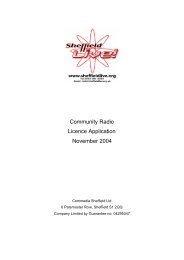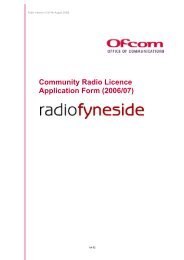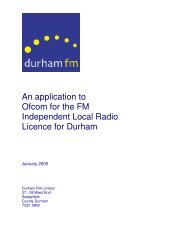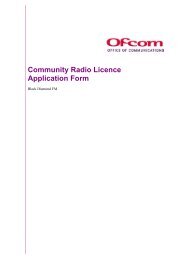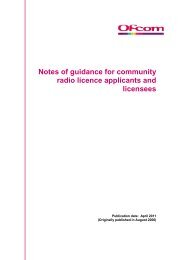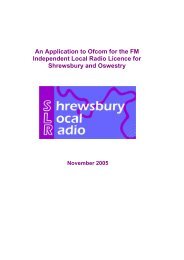UHF2 realignment study - Ofcom Licensing
UHF2 realignment study - Ofcom Licensing
UHF2 realignment study - Ofcom Licensing
You also want an ePaper? Increase the reach of your titles
YUMPU automatically turns print PDFs into web optimized ePapers that Google loves.
7.5.5 Summary of the benefits<br />
Previous estimates of benefits of band alignment need to be re-assessed given the<br />
significant changes that have occurred in both the policy and market environment since<br />
many of the studies were completed.<br />
The introduction of spectrum trading means that many of the benefits of band alignment can<br />
now be achieved without direct intervention by the regulator. In addition, technological<br />
advances have meant that the costs of managing continental interference for existing<br />
spectrum users in the 450-470 MHz frequency band have been significantly reduced. This, in<br />
turn, has reduced the size of benefits that would accrue by aligning the band. For more<br />
details on these changes, see Chapters 3 and 4.<br />
As a result of theses developments we have significantly discounted previous research on<br />
the benefits of band alignment. Instead, we have carried out our own analysis on the likely<br />
use of the spectrum that is freed up as a result of band alignment. We have also examined<br />
the value of that spectrum based on our expectations of the likely revenues that will accrue<br />
to Government through allocating the spectrum to the market and the associated AIP pricing<br />
that would result. In terms of the benefits from reduced interference, our modelling has<br />
provided an estimate of the actual net impact of band alignment, taking into account the<br />
impact of current technologies that can manage continental inference without the need for<br />
band alignment. Chapter 8 discusses this in more detail and provides our estimate of the<br />
size of these benefits.<br />
7.6 Distribution of costs and benefits<br />
Cost-benefit analysis is typically not concerned about how the cost or benefits are distributed<br />
among consumers or producers. However, as highlighted by a number of previous studies<br />
into the costs and benefits of band alignment, the issue of how the benefits and costs are<br />
distributed is of critical importance for public policy.<br />
Earlier studies indicated that the benefits of band alignment tended to be concentrated on<br />
those spectrum users on the South East coast of the UK (where continental interference<br />
risks exist), while costs are shared across all users in the band. Hence, many spectrum<br />
users receive no benefit from band alignment – but may face considerable costs. This is<br />
demonstrated in the continental interference differences between the Thames Gateway and<br />
Bradford in Chapter 6.<br />
In defining the options to be studied as part of the cost-benefit <strong>study</strong>, we have tried to be<br />
cognisant of the impact of each of the options on spectrum users. As well as reviewing the<br />
size of net-benefits for each of the options, we also review the net-impact on spectrum users.<br />
Minimising the impact of band alignment on spectrum users will be one of the factors to be<br />
considered when making our recommendations on the preferred route for achieving the<br />
policy aims of band alignment.<br />
240689 - 450-470 Study Final Print<br />
Version (Dec08).doc<br />
Page 76<br />
abc





